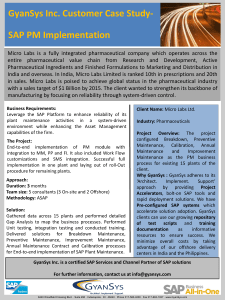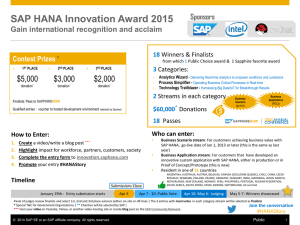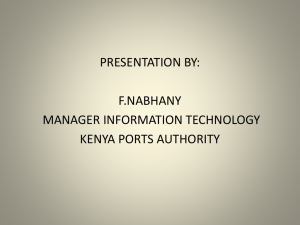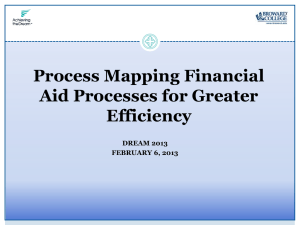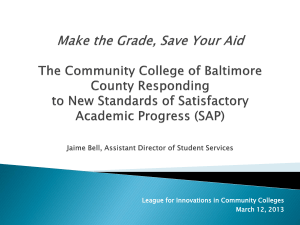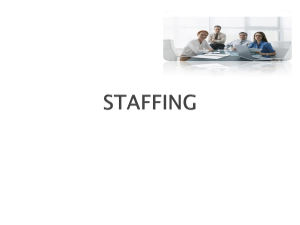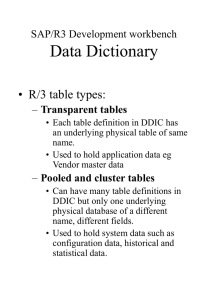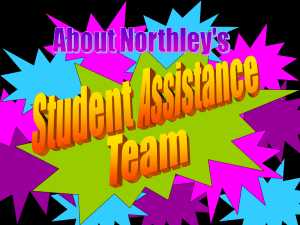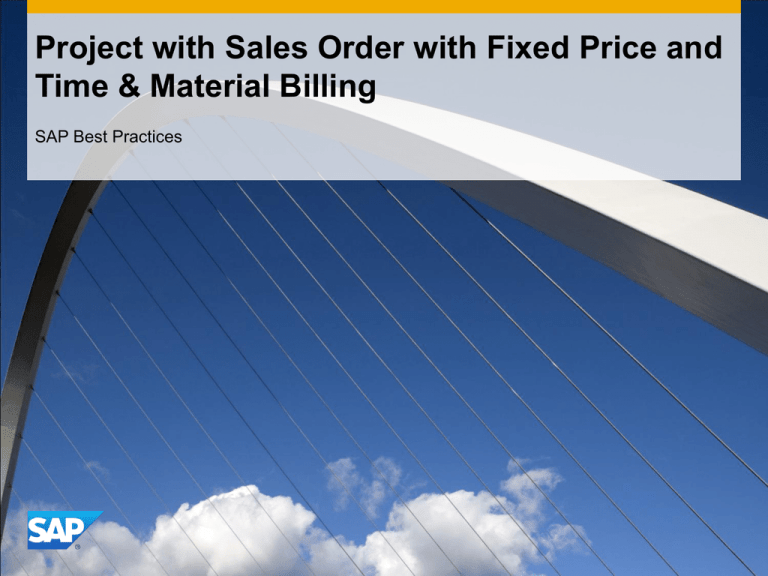
Project with Sales Order with Fixed Price and
Time & Material Billing
SAP Best Practices
Purpose, Benefits, and Key Process Steps
Purpose
This business scenario addresses the typical business processes of an industrial design, consulting, or professional
services company.
Benefits
Sales Order Management
Project Management
Cross-Application Time Sheet
Staffing and Forecast on Assignment
Non-billable expenditure items
Fixed Price and Resource-Related Billing
On-Account Billing
Billing Request Editor
Projection of Revenue and Cost of Sales
Key Process Steps
Creating a Quotation
Creating a Sales Order
Maintaining Realization % on Order Item Line
Generating the Settlement Rule
Changing the Project
Staffing the Project
Planning Cost Elements/Activity Inputs
Entering a Forecast
Determination of projected revenue and cost of sales for forecast periods
Analyze projected revenue and cost of sales
© 2011 SAP AG. All rights reserved.
2
Purpose, Benefits, and Key Process Steps
Key Process Steps - continuation
Time Recording (211)
Travel Management (191)
Creating the Fixed Price Billing Document
Creating and Invoicing an On-Account Payment Request
Creating a Resource-Related Billing Request
Processing the Billing Request in the Billing Request Editor
© 2011 SAP AG. All rights reserved.
3
Required SAP Applications and Company Roles
Required SAP Applications
Enhancement package 5 for SAP ERP 6.0
Company Roles
Consulting Agency Client Manager
Project Manager
Consulting Agency Client Manager (Service)
Employee (Professional User)
© 2011 SAP AG. All rights reserved.
4
Detailed Process Description
Project with Sales Order with Fixed Price and Time & Material Billing
This business scenario addresses the typical business processes of a company that
manages commercial projects (i.e. projects not requiring the extensive logistical capabilities
provided by a project network and network activities ). The project is automatically created
from the sales order using a predefined project structure template. The company finalizes
the project structure and assigns employees to specific activities based on skill sets and
availability. Invoicing is carried out on the basis of the fixed-price and resource-related
items set up in the sales order, and leaves out expenditure items not intended to be billed.
The scenario also features forecast of working hours and revenues: the employees
maintain the expected workload for upcoming periods. These figures are then processed by
the resource-related billing functionality, applying the same rates as if billing was carried
out. As a result, reasonable values for plan revenues are determined, which can then be
analyzed in reporting for the future periods.
Additional optional steps are integrated in this scenario which are designed to enhance and
simplify the invoicing of resource-related activities. First, On-Account Billing enables partial
payments to be requested from customers before the final invoice is submitted. Second,
debit memo requests generated by the resource-related billing transaction can be
processed in a flexible and efficient manner using the Billing Request Editor.
© 2011 SAP AG. All rights reserved.
5
Process Flow Diagram
Purchase order
formalizing request for
a project is received
Creating a
Quotation
Creating a
Consulting
Order
Maintain
Realization %
on order item
line
Creating the
Fixed Price
Billing
Document
Generating the
Settlement
Rule
Staffing the
Project
Determination
of projected
revenue and
cost of sales
Analyse
projected
revenue and
cost of sales
Reviewing and
Changing the
Project
Planning Cost
Elements /
Activity Inputs
Consulting Agency
Client Manager
(Service)
Employee
Consulting Agency Project
Manager
Consulting
Agency Client
Manager
Event
Project with Sales Order with Fixed Price and Time & Material Billing
© 2011 SAP AG. All rights reserved.
Entering a
Forecast
Time
Recording
(211)
Creating an
On-Account
Payment
Request
Creating
ResourceRelated Billing
Request
Close
Completed
Projects
(technical
view)
Travel
Management
(191)
Processing the
Billing
Request in the
Billing
Request Editor
6
Legend
<Function>
Symbol
Description
Usage Comments
Band: Identifies a user role, such as Accounts
Payable Clerk or Sales Representative. This band
can also identify an organization unit or group,
rather than a specific role.
Role band contains
tasks common to that
role.
Symbol
Diagram
Connection
The other process flow symbols in this table go
into these rows. You have as many rows as
required to cover all of the roles in the scenario.
External
to SAP
External Events: Contains events that start or end
the scenario, or influence the course of events in
the scenario.
Business
Activity / Event
Unit Process
Process
Reference
SubProcess
Reference
Process
Decision
Usage Comments
To next / From last Diagram: Leads
to the next / previous page of the
Diagram
Flow chart continues on the next /
previous page
Hardcopy / Document: Identifies a
printed document, report, or form
Does not correspond to a task
step in a document; instead, it is
used to reflect a document
generated by a task step; this
shape does not have any outgoing
flow lines
Financial Actuals: Indicates a
financial posting document
Does not correspond to a task
step in a document; instead, it is
used to reflect a document
generated by a task step; this
shape does not have any outgoing
flow lines
Budget Planning: Indicates a
budget planning document
Does not correspond to a task
step in a document; instead, it is
used to reflect a document
generated by a task step; this
shape does not have any outgoing
flow lines
Manual Process: Covers a task
that is manually done
Does not generally correspond to
a task step in a document;
instead, it is used to reflect a task
that is manually performed, such
as unloading a truck in the
warehouse, which affects the
process flow.
Existing Version / Data: This block
covers data that feeds in from an
external process
Does not generally correspond to
a task step in a document;
instead, this shape reflects data
coming from an external source;
this step does not have any
incoming flow lines
System Pass / Fail Decision: This
block covers an automatic
decision made by the software
Does not generally correspond to
a task step in the document;
instead it is used to reflect an
automatic decision by the system
that is made after a step has been
executed.
Hardcopy /
Document
Flow line (solid): Line indicates the normal
sequence of steps and direction of flow in the
scenario.
Flow line (dashed): Line indicates flow to
infrequently-used or conditional tasks in a
scenario. Line can also lead to documents involved
in the process flow.
Connects two tasks in
a scenario process or
a non-step event
Business Activity / Event: Identifies an action that
either leads into or out of the scenario, or an
outside Process that happens during the scenario
Does not correspond
to a task step in the
document
Unit Process: Identifies a task that is covered in a
step-by-step manner in the scenario
Corresponds to a task
step in the document
Financial
Actuals
Process Reference: If the scenario references
another scenario in total, put the scenario number
and name here.
Corresponds to a task
step in the document
Sub-Process Reference: If the scenario references
another scenario in part, put the scenario number,
name, and the step numbers from that scenario
here
Corresponds to a task
step in the document
Process Decision: Identifies a decision / branching
point, signifying a choice to be made by the end
user. Lines represent different choices emerging
from different parts of the diamond.
Does not usually
correspond to a task
step in the document;
Reflects a choice to
be made after step
execution
© 2011 SAP AG. All rights reserved.
Description
Budget
Planning
Manual
Process
Existing
Version /
Data
System
Pass/Fail
Decision
7
Appendix
Master Data Used
Operating concern
Controlling area
Company code
Sales organization
Distribution channel
Division
Order type
Sold-to party
Material
CATS Data entry profile
Personnel number
© 2011 SAP AG. All rights reserved.
8
© 2011 SAP AG. All rights reserved
No part of this publication may be reproduced or transmitted in any form or for any purpose
without the express permission of SAP AG. The information contained herein may be
changed without prior notice.
Some software products marketed by SAP AG and its distributors contain proprietary
software components of other software vendors.
Microsoft, Windows, Excel, Outlook, and PowerPoint are registered trademarks of Microsoft
Corporation.
IBM, DB2, DB2 Universal Database, System i, System i5, System p, System p5, System x,
System z, System z10, System z9, z10, z9, iSeries, pSeries, xSeries, zSeries, eServer,
z/VM, z/OS, i5/OS, S/390, OS/390, OS/400, AS/400, S/390 Parallel Enterprise Server,
PowerVM, Power Architecture, POWER6+, POWER6, POWER5+, POWER5, POWER,
OpenPower, PowerPC, BatchPipes, BladeCenter, System Storage, GPFS, HACMP,
RETAIN, DB2 Connect, RACF, Redbooks, OS/2, Parallel Sysplex, MVS/ESA, AIX,
Intelligent Miner, WebSphere, Netfinity, Tivoli and Informix are trademarks or registered
trademarks of IBM Corporation.
Linux is the registered trademark of Linus Torvalds in the U.S. and other countries.
Adobe, the Adobe logo, Acrobat, PostScript, and Reader are either trademarks or
registered trademarks of Adobe Systems Incorporated in the United States and/or other
countries.
Oracle is a registered trademark of Oracle Corporation.
UNIX, X/Open, OSF/1, and Motif are registered trademarks of the Open Group.
Citrix, ICA, Program Neighborhood, MetaFrame, WinFrame, VideoFrame, and MultiWin are
trademarks or registered trademarks of Citrix Systems, Inc.
HTML, XML, XHTML and W3C are trademarks or registered trademarks of W3C®, World
Wide Web Consortium, Massachusetts Institute of Technology.
Java is a registered trademark of Sun Microsystems, Inc.
JavaScript is a registered trademark of Sun Microsystems, Inc., used under license for
technology invented and implemented by Netscape.
Business Objects and the Business Objects logo, BusinessObjects, Crystal Reports, Crystal
Decisions, Web Intelligence, Xcelsius, and other Business Objects products and services
mentioned herein as well as their respective logos are trademarks or registered trademarks
of Business Objects Software Ltd. Business Objects is an SAP company.
Sybase and Adaptive Server, iAnywhere, Sybase 365, SQL Anywhere, and other Sybase
products and services mentioned herein as well as their respective logos are trademarks or
registered trademarks of Sybase, Inc. Sybase is an SAP company.
All other product and service names mentioned are the trademarks of their respective
companies. Data contained in this document serves informational purposes only. National
product specifications may vary.
The information in this document is proprietary to SAP. No part of this document may be
reproduced, copied, or transmitted in any form or for any purpose without the express prior
written permission of SAP AG.
This document is a preliminary version and not subject to your license agreement or any
other agreement with SAP. This document contains only intended strategies, developments,
and functionalities of the SAP® product and is not intended to be binding upon SAP to any
particular course of business, product strategy, and/or development. Please note that this
document is subject to change and may be changed by SAP at any time without notice.
SAP assumes no responsibility for errors or omissions in this document. SAP does not
warrant the accuracy or completeness of the information, text, graphics, links, or other items
contained within this material. This document is provided without a warranty of any kind,
either express or implied, including but not limited to the implied warranties of
merchantability, fitness for a particular purpose, or non-infringement.
SAP shall have no liability for damages of any kind including without limitation direct,
special, indirect, or consequential damages that may result from the use of these materials.
This limitation shall not apply in cases of intent or gross negligence.
The statutory liability for personal injury and defective products is not affected. SAP has no
control over the information that you may access through the use of hot links contained in
these materials and does not endorse your use of third-party Web pages nor provide any
warranty whatsoever relating to third-party Web pages.
SAP, R/3, SAP NetWeaver, Duet, PartnerEdge, ByDesign, SAP BusinessObjects Explorer,
StreamWork, and other SAP products and services mentioned herein as well as their
respective logos are trademarks or registered trademarks of SAP AG in Germany and other
countries.
© 2011 SAP AG. All rights reserved.
9


